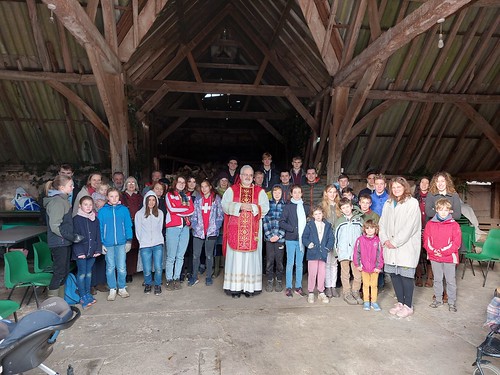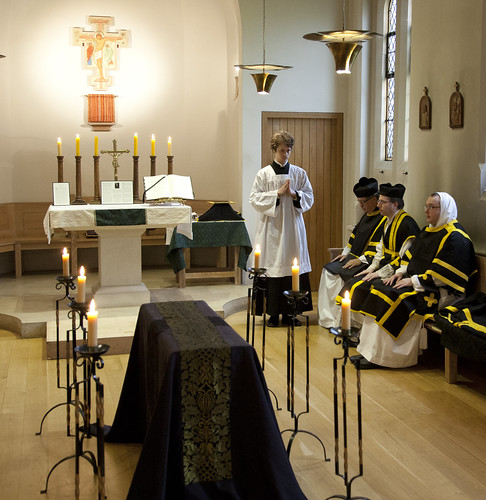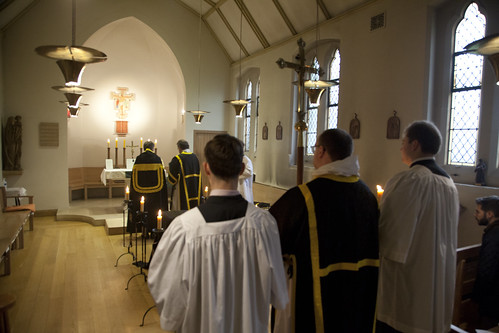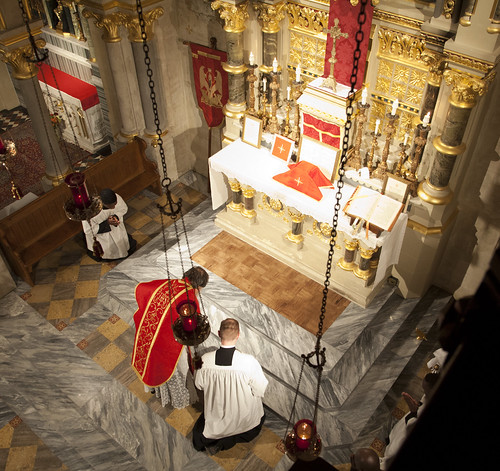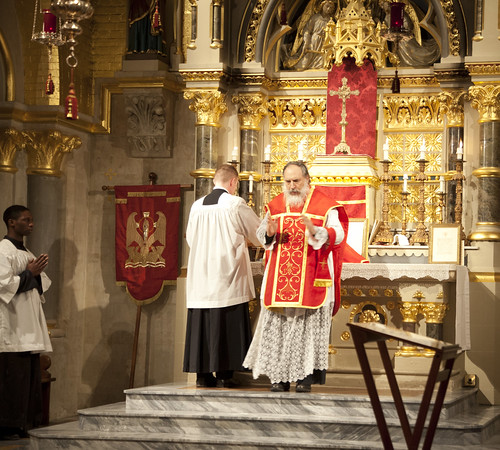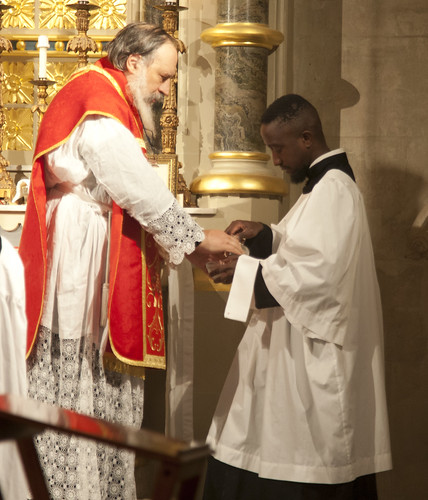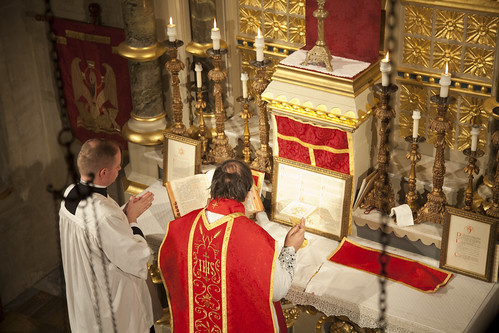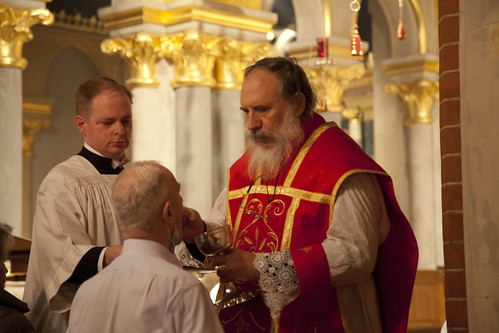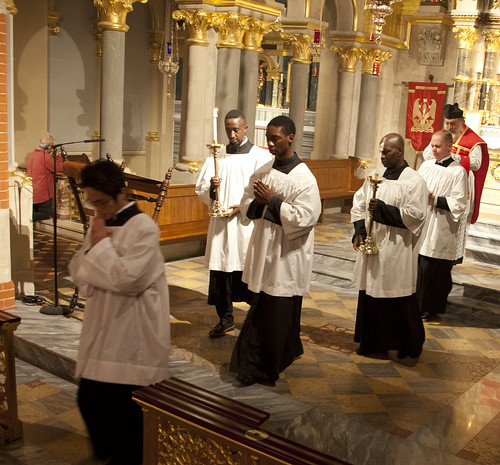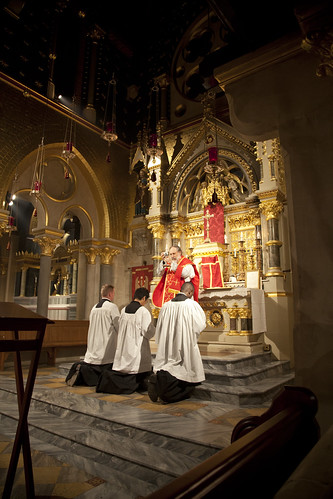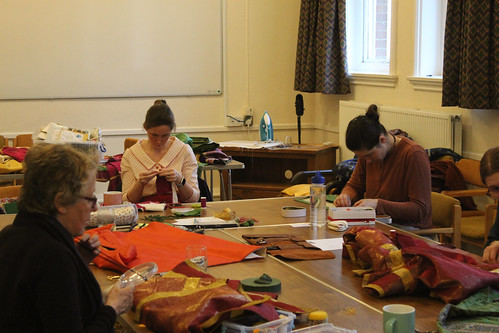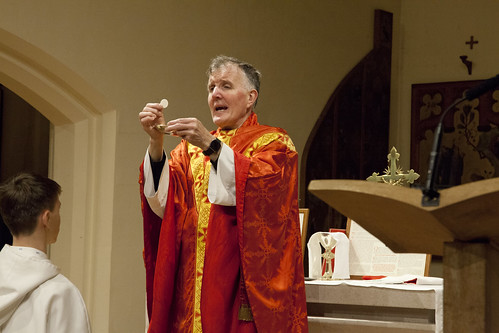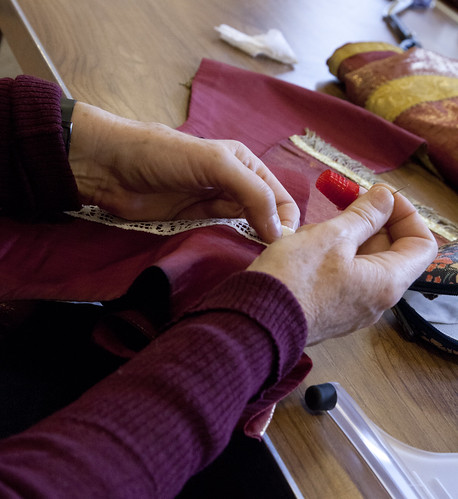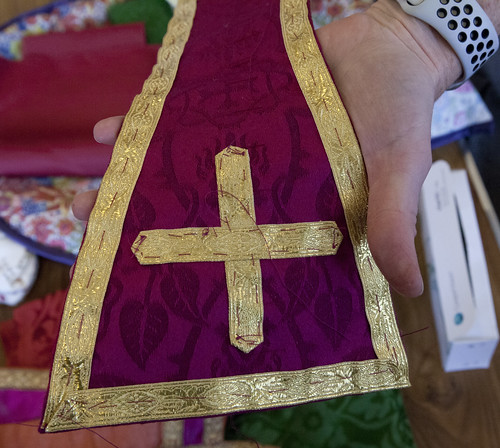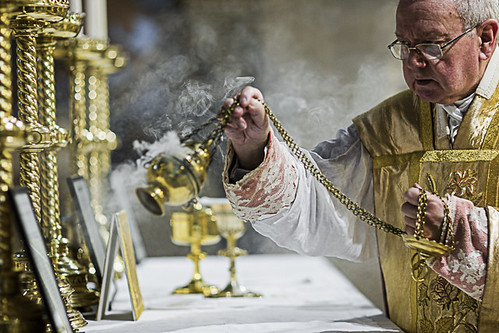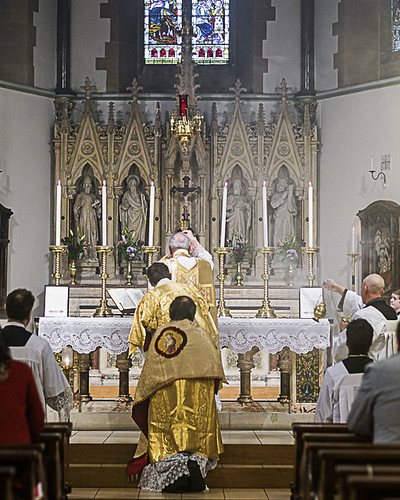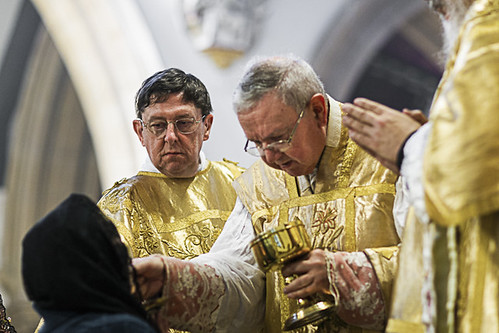Chairman's Blog
Pilgrimage to Lyford Grange
Annual Requiem in St Benet's Hall
It is always said by Fr Edward van den Burgh of the London Oratory, an alumnus of the Hall, and accompanied with chant by the Schola Abelis, Oxford's Catholic chant schola, which I founded. This year we were directed by Matthew Vine.
We usually manage a High Mass, as this year. The deacon was the Rev James Forde-Johnson, a permanent deacon, and the subdeacon was Dominican from just down the road in Blackfriars, Br Albert Robertson.
An anti-Christian cultural hegemony
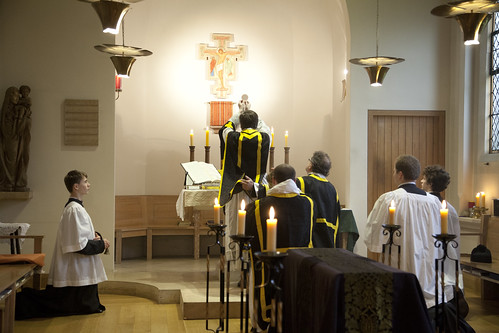 |
| Mass last Saturday: annual Requiem in St Benet's Hall, Oxford. |
My latest on Voice of the Family
Mantel, like the author Philip Pullman, seems to have “issues”, as the modern jargon has it, with Catholic faith and culture. She has no intrinsic significance — there have always been strange people around — what is important is the use which has been made of her: she has been awarded all kinds of prizes and her repulsive novels have been adapted for the Royal Shakespeare Company. Pullman, another winner of multiple awards, has had one book made into a film and another into a play. Both writers have received the accolade of special editions of their works done for the bibliophiles of the Folio Society.
The publicity machines have nevertheless found it difficult to explain these peculiar individuals. Mantel was initially praised for the historical accuracy and realism of her work but, as real historians began to notice her material, she hastily rebranded it as a very fictional kind of historical fiction. After pocketing prizes for children’s books, Pullman decided, as his graphic descriptions of child torture began to get a bit out of hand, that this was just a misunderstanding; no, he was writing for adults.
Such U-turns would have sunk lesser folk, but the secularist establishment needs Mantel and Pullman. They possess some literary skill and their work can be used to counter-balance and even to exclude the Christian narratives given to us by writers of a previous generation: notably, Robert Bolt’s play and film, A Man for All Seasons, about St Thomas More, and the children’s books of C.S. Lewis. Literature and historical memory is being remade in the snarling image of secular modernity.
Mass celebrated for Vladimir Ashkenazy
As well as presenting the distinguished conductor and pianist Vladimir Ashkenazy with the De Saventhem Medal, the Federation had a Mass celebrated for the good estate of his family through the Latin Mass Society, on the feast of St Cecelia, the Patron Saint of music. (More about this here.)
It was a Missa Canata, celebrated by Fr Gabriel Diaz Patri, and accompanied by polyphony sung by the Southwell Consort led by Dominic Bevan.
Support the Latin Mass Society
Response to Fr Ruff on Liturgical Polarisation
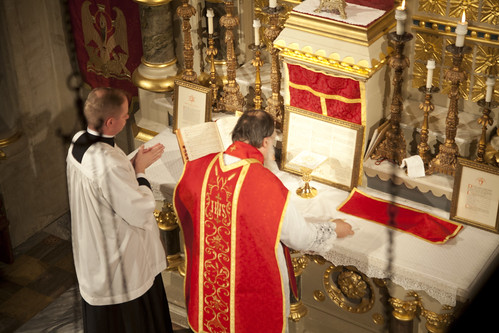 |
| Mass for Vladimir Ashkenazy and family at Maiden Lane last week. |
either one supports Vatican II and the reformed liturgy to the exclusion of the preconciliar liturgy, or one shows greater or lesser openness to the preconciliar liturgy, which seems to be equated with opposition to Vatican II.
He does not pause to explain what "opposition to Vatican II" might mean, but admits that not everyone falls into these two strictly opposed camps:
people who don’t fit neatly in either camp... [who] don’t see the preconciliar liturgy as particularly bad or harmful and don’t mind attending it at times.
Fr Ruff would like such people to realise
that the preconciliar liturgy is incompatible with the large advances made by the Second Vatican Council in ecclesiology and liturgical theology and inculturation and all the rest.
He gives the impression that he would like to see the Church become two armed camps snarling at each other from their trenches, with barbed wire, if not clouds of poison gas, marking out no-man’s land. But as for what these Vatican II "advances" might be, Fr Ruff does not say.
Fr Ruff blames Pope Benedict for “pushing people into two opposing liturgical camps”, but seems eager to do exactly this himself. In fact Pope Benedict favoured the unpolarised position, of “not seeing the preconciliar liturgy as being particularly bad or harmful”, and under his influence this position has become the normal one in many places: a liturgical live-and-let-live.
What exactly is wrong with this? Fr Ruff is coy about what features of the ancient liturgy are incompatible with what teachings of the Church, or are harmful in what way. I am speculating here but am willing to hazard a couple of suggestions as to why that might be.
Perhaps Fr Ruff and his allies fear that if they were a little more open, if the veil were lifted a little on their thinking, it would emerge that they think that the whole Church, East and West, for the whole of its recorded liturgical history, has been promoting “bad and harmful” liturgical practice. Is this what liturgical progressives say to each other when they've had a couple of drinks? It would after all only be a mild extension of the attitude of the reform-minded scholar of the 1940s, Josef Jungmann, who said that a "fog" descended to obscure the liturgy from the people in the 8th century because they could not longer understand Latin. Why stop there? The Canon of the Mass was being said silently for at least two centuries before that: an even more effective barrier to comprehension, presumably.
If Fr Ruff and his allies have some terribly clever theological position which resolves all these difficulties, it would be a service to the Church for them to share it with the rest of us. I mean this in all seriousness. Liturgical traditionalists have been asking to see these arguments for fifty years. Stop gesturing vaguely towards "inculturation" and "all the rest": tell us what exactly is so bad about the Old Mass, and why? What possible argument could be made against it which would not up-end the infallibility of the Ordinary Magisterium, or, more simply, the credibility of the Church as an authority in the spiritual life?
Neither Vatican II nor the post-Concilar Popes, including Pope Francis, claim that the older liturgy was “harmful”. The idea is ludicrous. Paul VI, John Paul II, and Pope Francis have all praised it, not just Pope Benedict: Pope Francis waxed quite lyrical about how "we in the West" have "lost the sense of adoration" due to the liturgical reform, in an interview in 2013. I give all the quotations in my contribution to Peter Kwasnieski's From Benedict’s Peace to Francis’ War.
In common with Benedict XVI, I deplore the fact that “in many places the prescriptions of the new Missal are not observed in celebration, but indeed come to be interpreted as an authorization for or even a requirement of creativity, which leads to almost unbearable distortions.”
Guild of St Clare: Sewing Retreat photos
Last weekend was the Autumn Retreat of the Guild of St Clare. These are 'sewing retreats': with daily Mass and other devotions, and spiritual conferences from the retreat-giver each day, the participants mend vestments. This retreat took place in Douai Abbey.
The number of man-hours which goes into some of these vestments is immense. In addition to two annual Sewing Retreats (Friday to Sunday), the Guild has a 'Vestment Mending Day' in London every two months, and occasionally one in Oxford. With all these opportunities to make progress on various sets of vestments, mostly belonging to the Latin Mass Society, worn places are patched, linings replaced, embroidery repaired, braid stitched back down, and missing items are replaced. The Latin Mass Society has been given a great many sets missing a maniple, stole, chalice veil, or burse, or (usually) some combination of these.
The Guild accepts help from people of all levels of skill: there are always tasks to match what you can do. These occasions are also opportunities to learn new things, and the Guild also arranges training sessions with professionals and is sponsoring two students through the Royal School of Needlework Certificate Course. Both of these took part in the Retreat.
After the repeated cancellations of the Covid epidemic it was good to be back in a face-to-face event. The next sewing retreat, which is already almost fully booked, will be 4th-6th February, in a new venue: Park Place Pastoral Centre in Hampshire: full details and booking on the LMS website. The one after that will take place 4th-6th November in the same place: booking is now open.
LMS Bedford Pilgrimage in Reparation for Abortion
Mass setting: Tomas Luis de Victoria - Missa Trahe Me Post Te
Offertory motet: Giovanni Pierluigi da Palestrina - Ave Maria a 5
Communion motet: Juan Gutierrez de Padilla - Stabat Mater
Letter in the Tablet: the value of the Old Mass
 |
| View from the choir loft at St Mary Moorfields, for the LMS' Easter Triduum 2018 |
I'm late with this, but I think it is worthy of a wider audience: part of a Letter in the Tablet from the 23rd October issue. All credit to them for publishing it.
Mr Wells' transformative liturgical experience sounds to me like on of the Masses organised in St Patrick's Soho Square and then in St Mary Moorfield's by Juventutem London before the lockdown, which were sponsored by the Latin Mass Society. (These continue, at the moment, in St Mary Magdalen, Wandsworth, in a slightly different format: 7pm on Fridays.) The organisers, including the then musical director Matthew Schellhorn of Cantus Magnus, should be reminded that their efforts were not without fruit.
On graduation I returned to my home parish where, for me, the post-conciliar vernacular Mass that had worked so well in the university chaplaincy seemed arid in a parish setting; perhaps the church building was too big for the new informality. Anyway, one evening I went to a Tridentine High Mass in central London, and what a difference: Gregorian chant drifting down from the gallery, the sacred ministers involved in the ritual of the Prayers at the Foot of the Altar, the gentle formalised approach of the whole service.
And that is what I crave when I go to Mass. I have no wish to split the Church or to denounce the present Pope. But I would like to worship God in the way that best leads me to him. Is that too much to ask?
IAN WELLS
NOTTINGHAM
Do your Christmas shopping and support the Latin Mass Society
The Latin Mass Society's online shop has continued to expand, and our offerings for Christmas are extensive: six Christmas cards based on classics of the Church's artistic patrimony (Botticelli, as in the image on the left, Giotto, etc.), Advent calendars, Nativity sets, seasonal devotional books: a selection you might have seen in a large and well-stocked off-line Catholic bookshop before nearly all of them closed down. Plus our regular stock which contains an excellent selection of books, including ever-changing stock of second hand ones, and devotional items. Do check it out!
Just visit the easyfundraising site and all will be explained. The donations vary in size; some are fixed sums, some are percentages. It's not much but it adds up. If thousands of UK Catholics consistently did their shopping this way in favour of the Latin Mass Society or Aid to the Church in Need, it would raise a very real sum of money.
The Winter Mass of Ages has arrived!
Mass of Ages
In this issue:



